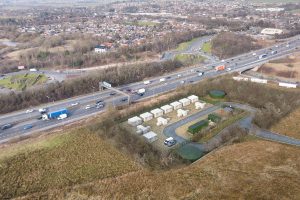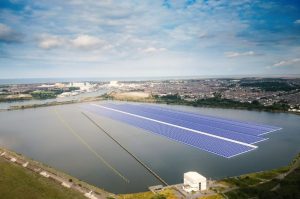Construction work begins on energy storage plant following £300m funding round

Work has now started on the UK’s first commercial-scale liquid air energy storage (LAES) plant at Carrington in Manchester.
London-based Highview Power has secured the backing of the UK Infrastructure Bank and energy industry leader Centrica in the £300m funding round, alongside a syndicate of investors including Rio Tinto, Goldman Sachs, KIRKBI and Mosaic Capital.
The investment will enable the construction of one of the world’s largest long duration energy storage (LDES) facilities in Carrington, using Highview’s proprietary LAES technology which can store excess renewable energy for up to several weeks, longer than battery technologies.
Effective storage of excess energy produced by renewables is seen an essential element of the energy transition.
Construction will begin immediately on the plant which, when complete in early 2026, will have a storage capacity of 300 MWh and an output power of 50 MWs per hour for six hours.
Richard Butland, co-founder and CEO of Highview Power, said: “There is no energy transition without storage. The UK’s investment in world-leading offshore wind and renewables requires a national long duration energy storage programme to capture excess wind and support the grids transformation.

Richard Butland and site model
“UKIB and Centrica and our partners have today backed our ambitious plan to bring renewable energy storage into the UK economy at scale, liberating the potential of what is both the greenest and by far the cheapest energy source for the UK economy and provide energy security. Our first project in Carrington will be the foundation for our full scale roll-out in the UK and expansion with partners to share this British technology internationally.”
Chris O’Shea, Group Chief Executive, Centrica, said: “The energy transition is an opportunity that could transform lives across the UK. But with a changing energy mix, and more intermittency from renewables, we have to explore new, innovative ways to store energy so our customers have electricity available when the wind doesn’t blow and the sun doesn’t shine. Low carbon storage is an essential part of the solution when looking at how we manage peaks in demand.
“Not only are we bringing capital to the table to support roll-out and expansion, but we’ll be also sharing our expertise on the energy transition and power storage. Through partnerships like this we can manage the challenges net zero might present while providing cleaner, greener power to customers.”
Mayor of Greater Manchester, Andy Burnham, said: “My vision is for Greater Manchester to be a leader in the green transition – and Highview Power’s decision to build one of the world’s largest long duration energy storage facilities at Carrington is a huge boost for the region.
“This new plant will deliver renewable energy to homes and business across our region and bring world-leading technology, jobs, skills and investment to Greater Manchester.”
Law firm Addleshaw Goddard advised Highview Power on the equity capital raise, together with wider aspects of the project development including construction, property and IP, with a team of more than 30 lawyers from the firm led by Paul Jones and including James Reynolds, Amanda Davis and Georgina Powling.
Paul Jones said: “Harnessing technologies such as LAES is essential for the UK as it transitions to net zero and it is fantastic to see the project reach this stage, which establishes our country at the cutting edge of energy storage.
“Our team has extensive experience of advising on ‘first-of-a-kind’ projects which present new challenges and we can’t wait to see the plant become operational and look forward to the roll out of more facilities across the UK.”
Highview Power has plans for four larger scale 2.5 GWh facilities, with a total anticipated investment of £3bn. These plants would provide stability services to the National Grid, allowing for long term replacement of fossil fuel-based power plants for system support.
The technology works by using electricity to cool and compress air, turning it into liquid and storing it in industrial-sized containers.
It then feeds the liquid through a turbine, turning it back into electricity and pumping it back into the grid when it is needed.
This will give the UK far greater flexibility in helping meet the country’s electricity needs from the grid and when up and running could be used to power as many as 200,000 homes for five hours a day.








